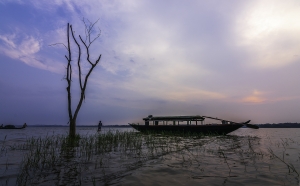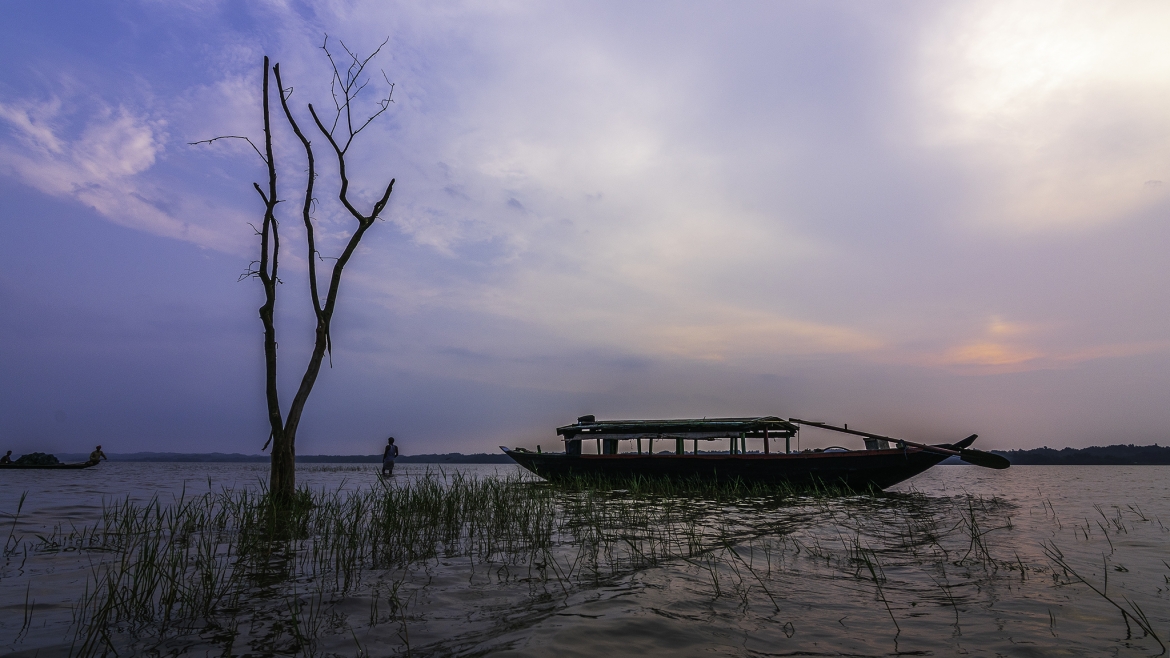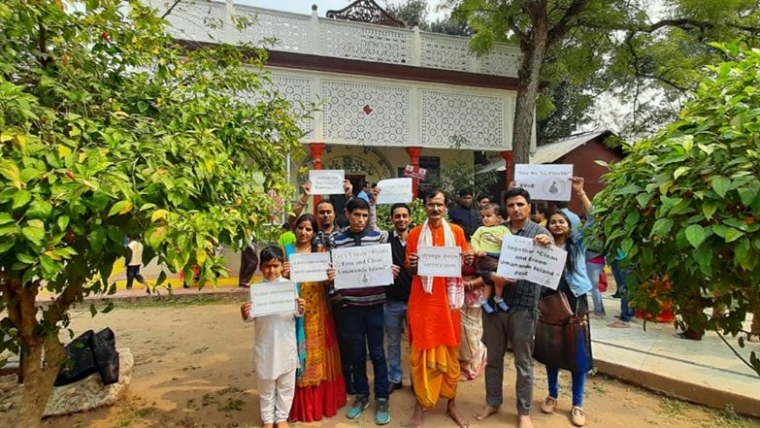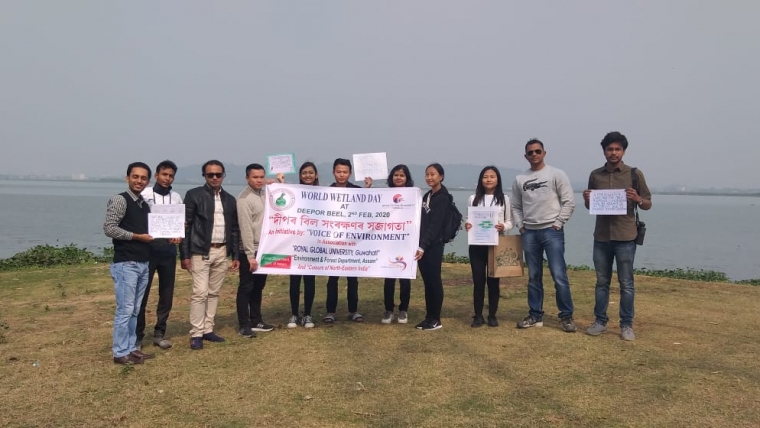Achieving Agenda 2030 Needs Big Push to Scale-up Wetland Conservation, Wise-use & Restoration
Wetlands are pertinent for our wellbeing, inclusive economic growth & climate mitigation & adaptation. They are the biggest source of fresh water for our consumption, agriculture & maintaining our ground water table by naturally recharging & filtering it. They act as a natural water sink. They are the biggest terrestrial ecosystem for carbon sequestration & acting as a natural systematic carbon sink system. They act as an ‘Ecosystem System Based Disaster Risk Reduction’ structure protecting shores & providing cities & settlements a safe & climate resilient prospect. They provide sustainable livelihoods for the community welfare & offer a healthy ecosystem for exploring multiple ecosystem services & benefits in parallel to abundant biodiversity such ecological systems support. This multiple benefits & services provided by wetlands are significant in achieving Sustainable Development Goals/SDGs.

The Ramsar Convention’s fourth strategic plan (2016-24) identifies 4 overarching goals & 19 specific targets in the wake of Agenda 2030.
Goals & Specific Targets of 4th Ramsar Strategic Plan:
- Addressing Drivers of Wetlands Loss & Degradation
- Featuring wetland benefits in National/Local policy strategy & plans focussing to key sectors water, energy, mining, agriculture, tourism, urban development, infrastructure, industry, forestry aquaculture, fisheries at the National & Local Level. (Target 1)
- Ensuring appropriate amount of water a wetland ecosystem needs for providing benefits & services. (Target 2)
- Implementing wise use planning guidelines in public & private sector. (Target 3)
- Prioritizing systematic identification of invasive alien species & thereafter managing a plan framework for controlling & eradicating such species. (Target 4)
- Effectively Conserving & Managing Ramsar Site Network
- Effective planning & integrated management to restore & maintain ecological character of Ramsar sites. (Target 5)
- Expanding wetland areas under Ramsar Designation of Wetlands of International Importance. (Target 6)
- Addressing risk of threats of change in ecological character. (Target 7)
3. Wisely Using All Wetlands
- Completing national wetland inventories for promoting the conservation & effective management of all wetlands. (Target 8)
- Strengthening Wise use of wetlands for integrated management of river basin or coastal zone. (Target 9)
- Respecting & using indigenous knowledge resource for the wise use of wetland management plan. (Target 10)
- Documenting wetlands functions, services & benefits. (Target 11)
- Restoration of degraded wetlands prioritizing biodiversity conservation, livelihoods, disaster risk reduction & climate change mitigation & adaptation. (Target 12)
- Enhancing sustainability in key sectors; water, energy, mining, agriculture, tourism, urban development, infrastructure, industry, forestry aquaculture, fisheries, when they affect wetlands, contributing to the biodiversity conservation & human livelihoods. (Target 13)
4. Enhancing Implementation
- Developing guidance & political methodologies at global & regional levels. (Target 14)
- Reinforcing Ramsar Regional Initiatives for the full implementation of the convention. (Target 15)
- Mainstreaming wetland conservation through Communication, Capacity Development, Education, Participation & Awareness/ CEPA (Target 16)
- Mobilizing resources for implementation. (Target 17)
- Strengthening international cooperation (Target 18)
- Building capacity to implement the convention & strategic plan. (Target 19)
Wetlands Role in Achieving SDGs:
SDG 1 End Poverty in All Its Forms Everywhere
Building resilience of the poor & vulnerable is one of the targets under this goal & one where the role of wetlands can be clearly illustrated. Wetlands provide a clean potable drinking source of water, (Even during drought period) for cattle, agriculture & human consumption. In Cameroon, restoration of Waza Floodplain, a Ramsar site helped to reinstate the flooding regime. It resulted into an improvement of gross livelihoods; agricultural yield, grazing & fishing thus generating economic benefits estimated at $2.3 Million per Year.
Changes in tidal marshes & mangroves have led to an estimated ‘Global Financial Depletion’ of $7.2 trillion per year & those from declining coral reef is $11.2 trillion annually. This reflects an enormous depletion of revenue & potential livelihoods of marginalized & vulnerable communities globally. In Malawi, Lake Chilwa Wetland is home to extremely poor & marginalized communities. Yet this wetland provides an abundant productive fish protein source to the surrounding inhabitants. Its gross monetary value is estimated to total $21 million per year. Recently Kingdom of Bhutan has identified & quantified the values (including food, genetic resources, DRR & cultural values) OF Bhutan’s inland wetlands for a total monetary value of USD 50 million per year. On a per hectare basis, inland wetlands are estimated to provide the highest values @ $14,183/hectare/year.
Target 1.5 of SDG 1 is committed to build resilience of the poor & those in the vulnerable situations & reduce their exposure & vulnerability to climate-related extreme events & other economic, social & environmental shocks & disasters by 2030. Loss of wetlands whether it is from climate change, upstream large hydropower establishments or anthropogenic causes severely affect the way of life & livelihoods of local surrounding communities. While it is hard to establish direct causality, there are number of studies linked between migration & water scarcity.
SDG 2 End Hunger, achieve food security & improve nutrition & promote sustainable agriculture
Food production relies largely on water from man-made & natural wetlands. Rice is one of the staple crops feeding half of the world population is grown mainly in man-made & natural wetlands. Wetlands store an enormous mass of water to be utilized to irrigate land under cultivation. Wetlands are an important source of food protein to many people around the world. In Cambodia, fish from large Tonle Sap Lake & associated floodplains which include two Ramsar Sites, provide communities with 60%-80% of their animal protein. Wetlands are the home of many edible species which provide food security to the local communities.
SDG 5 Achieve Gender Equality & Empower All Women & Girls
Internationally we are aware of how women are predominantly responsible for food collection & agriculture, & for water collection & management. Women’s role & their instinctive knowledge resource has been predominantly unrecognized & unnoticed, & social & economic norms often impose discriminatory & unequal approach towards bringing women’s participation in decision making.
Wetlands conservation, management & restoration projects need to be gender sensitive recognizing the differentiated knowledge, roles, needs & vulnerabilities of men & women & continuing to empower women in governance & decision making. COP 13 considers a draft resolution which confers a process to increase awareness among contracting parties on the linkages between gender equality & wetlands management. Women have different access to & control over natural resources & information about how conservation & wise use shapes the way in which wetlands are managed, affecting their rights & customary uses wetlands products & services.
SDG 6 Ensure Availability & Sustainable Management of Water & Sanitation for All
Wetlands are critical to ensure water availability. Almost all of the freshwater is drawn directly or indirectly from wetlands. Wetlands provide a fundamental natural infrastructure for freshwater making wetlands a ground base to ensure water security for all. Wetlands are natural water filter. Wetlands vegetation capture nutrients, pollutants & sediments & thus, maintaining the quality of ground & surface water. Though mismanaged wetlands are heavily polluted & if used for irrigation or drinking water may prove lethal for human health. So restoring the functional quality of wetlands is critical for providing some life supporting intangible ecosystem services. Wetlands around Kampala act as a natural filter & prevent contamination to reach at Lake Victoria which is a critical drinking water source for 1.3 million inhabitants of the capital city.
Basin-level approach provides a framework for Payment for Ecosystem Services/PES. Large scale deforestation in the Atlantic Forest deteriorated the quality of water of River Parana which provides drinking water solely to Sao Paolo’s inhabitants. The Nature Conservancy started this PES Project led to major water users such water supply companies & industries to pay a fee to support farmers & ranchers to plant trees among riparian zones in the river’s headwaters. Target 6.6 seeks to protect and restore ecosystems. The Ramsar Convention is a co-custodian of Indicator 6.6.1 that monitors change in the extent of water-related ecosystems over time. The Convention provides data submitted by Contracting Parties on wetlands critical to monitoring the status & taking decisions on managing water ecosystems.
SDG 8 Promote Sustained, Inclusive & Sustainable Economic Growth, Full & Productive Employment & Decent Work for All
Economic growth models have so far been based on deteriorating, depleting & exploiting natural resources & we have created massive disaster risks over a period of time. Currently we have successfully designed concepts of ‘Green economy”, “Green Growth” & “Natural Capital” recognizing the significance of securing economic growth models that conserve & use sustainably our natural resources. Decoupling economic growth from ecological degradation is one of important targets & wetlands contribute to this target by providing water to agriculture & industrial production such as nutrient recycling, protection against flooding & water filtration naturally otherwise it would have needed a massive cost of engineering to install such technologies. One of the targets of creating employment in tourism sector & wetlands prove 266 million jobs in tourism & travel services alone.
SDGs 9 Build Resilient Infrastructure, Promote Inclusive & Sustainable Industrialization & Foster Innovation
Intensifying climate uncertainties & extremities require advanced infrastructural protection measures. Since 1995 to 2015, flood & storms globally affected about 3 billion people damaging 87 million residences as well as 130,000 public buildings. Ecosystem based Disaster Risk Reduction/DRR could have been an effective & efficient solution building to mitigate & adapt to these mounting risks. Wetlands provide a cost-effective & efficient natural infrastructure against water related catastrophes. Despite restoring such natural pivotal ecosystem based DRR structures are costly affairs, they are less costlier than constructing engineered infrastructures for protecting coastal habitations from flooding & storms. South Africa’s ‘Working For Wetlands’ Programme combines water conservation with employment generation. It aims to restore degraded wetlands for smooth & continuous public water supply & generate jobs for the most marginalized people in the community. In Vietnam, Red Cross has paid $1.1 million to restore, protect & conserve 12,000 Hectares of mangroves to protect coastal zones & habitation from typhoons as well as offering subsidiary benefits of culturing molluscs, shrimps & seaweeds to supplement diets & income where it was estimated $7.3 million for dike maintenance earlier. Sustainable drainage system contribute to this target by using the landscape to control the flow & volume of surface water from rainfall, preventing & controlling pollution downstream & promoting ground water recharge.
SDGs 11 Make Cities & Human Settlements Inclusive, Safe, Resilient & Sustainable
Water related disasters including flood, drought, cyclone etc. account over 90% of overall disasters in last 2 decades. Ecosystem based Disaster Risk Reduction infrastructure such as mangroves, coral reefs, salt marshes provide low cost natural immunity to coastal regime by reducing wave height & potential strength, reducing storm surges & absorbing some of the excess water. It was observed during Hurricane Sandy in USA during 2012 these wetlands mitigated its dangerous & devastating impact in 12 provinces saving $625 million in flood damage. These low cost EcoDRR structure provide not only community resilient against water related risks but enabling communities to better adapt to climate change, & provide multiple ecosystem services. Wetlands serve as upstream retention basins protecting downstream cities from flood risk.
SDGs 13 Take Urgent Action to Combat Climate Change & Its Impacts
“Wetlands in all parts of the world share a significant role in DRR if wetlands are effectively managed & restored wherever necessary.” This is how Parties to the Ramsar Convention agreed in 2015. Wetland soils contain 35% of the world’s organic carbon. Coastal ecosystems in particular to mangroves, coral reefs, salt marshes, sea grass beds sequester two to four times carbon than terrestrial forests & these ‘Blue Carbon Ecosystem’ play a significant role in climate change mitigation. This carbon is stored for a persistent period in wetland soil preventing further degradation, drainage & depletion of wetlands ecosystem which is critical to prevent further Green House Gas Emissions/GHGs.
Peatlands contribute 3% of the earth’s surface but they hold twice as much carbon as world’s forests. Losing & mismanaged wetlands contribute to intensify climate change while restoring & conserving them shall help building resilience & climate change mitigation.
SDGs 14 Conserve & Sustainably Use the Oceans, Seas & Marine Resources for Sustainable Development
Around 3 billion people depend on marine resources for their essential primary source of protein supplement in their food. Recognizing the significance of marine resources to half the global population this goal stresses to reduce pollution, sustainably manage & protect coastal ecosystems, reduce overfishing & conserve at least 10% coastal & marine areas by 2020.
SDGs 15 Protect, Restore & Promote Sustainable Use of Terrestrial Ecosystems, Sustainably Manage Forests, Combat Desertification & Halt & Reverse Land Degradation & Halt Biodiversity Loss
Terrestrial ecosystems including Forests & wetlands & the biodiversity they hold, can be considered as nature’s gift to human. Target 15.1 specifically deals with conservation, restoration & sustainable use of terrestrial & fresh water ecosystems & their services including wetlands in specific. Wetlands have been estimated to provide 40% of global renewable ecosystem services. Though assessing gross ecosystem services of the wetlands in its monetary value is quite difficult The Economics of Ecosystem & Biodiversity has assessed & estimated potential natural capital value of ecosystem services & benefits these wetlands provide worldwide is at $36.2 trillion & that of forests at $19.5 trillion.
Agenda 2030 provides a broader roadmap for national & international policy action for governments, civil society, private sector & other State/Non-State actors to achieve SDGs for our present & future generations. Wetlands provide a wide range of natural capital flow in terms ecosystem services for the life & livelihood of people & community. The Commitment of Parties to the Ramsar Convention designating Ramsar sites, wetlands of International Importance to conserve & wisely use all their wetlands is critical in achieving the SDGs.
We need to ensure that wetland conservation, wise use & restoration are an integral part to SDGs planning & implementation. Contracting Parties to the Convention on wetlands should ensure that their efforts to implement Ramsar Strategic Plan are integrated into their SDGs planning & implementation efforts. Including wetlands & Ramsar Convention in National SDGs plan with an additional inventory on how wetlands conservation, protection, restoration & wise use are critical to achieve SDGs so that we can give larger emphasis on conserving & managing wetlands at local levels. Integrating wetlands services & benefits in Nationally Determined Contributions for the Paris Agreement on Climate Change is critical for achieving SDGs. Adopting policies & practices for the conservation & wise use of wetlands to prevent further depletion & degradation of wetlands is key to scale up wetlands intervention & minimizing local conflicts at the community level. Identification of services & benefits these Ramsar sites provide for people & environment when they are being designated to help improve understanding of a site’s values & subsequent proposed actions related to conserve, wise use & restore it.
Developing multi-stakeholders partnerships is critical means of implementation of wetland conservation, wise use & restoration. It is a much needed alignment to involve partnerships between different sector & level of society Ramsar Sites. Seizing opportunities & synergies with other sectors, conventions & priorities is the need to facilitate collaboration between different focal points at national conventions level & SDGs implementation level to advance broader landscape approaches to conservation & sustainable development related to Ramsar Sites & other World Heritage Sites. Increase funding of comprehensive actions in wetlands including Wetlands of International Importance is a reflection of the significance of such natural ecosystems not only from abundant biodiversity prospective but also with the prospective & role these ecosystems play in implementing, managing & achieving sustainable development for current & future generations.
(Kumar Deepak is working with United Nations Development Programme)



